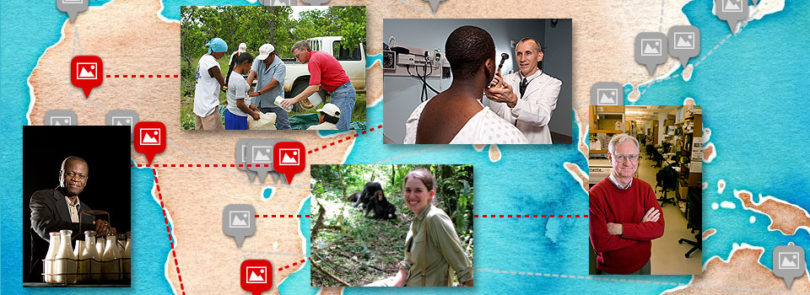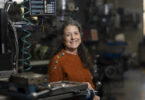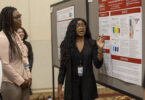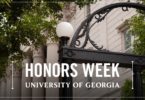A central component of the University of Georgia’s mission is to conduct cutting-edge research that contributes to the physical, emotional and economic well-being of the people of Georgia, the nation and the world. This commitment to excellence in research has led to many long-standing partnerships with communities in developing nations that need help fighting disease, feeding the hungry and bolstering emerging markets.
Through the dedicated work of its scientists and scholars, UGA is leading the charge for a better world by finding innovative solutions to some of society’s most vexing problems.
Africa is a hub for UGA research partnerships and projects. Current research includes:
Combating disease
Schistosomiasis and other neglected diseases have been at the center of Dan Colley’s professional life for nearly 40 years. Now as director of the UGA Center for Tropical and Emerging Global Diseases, he is embarking on what could be his biggest challenge yet. As the principal investigator on a $22 million grant from the Bill and Melinda Gates Foundation, Colley, a professor of cellular biology in the Franklin College of Arts and Sciences, leads an international team of scientists on a quest to dramatically reduce the burden of a disease that currently afflicts 200 million people, most of them in impoverished communities in Africa and South America.
As a young post-doctoral researcher at Yale who studied the immune system on a cellular level, Colley didn’t know what schistosomiasis was when he volunteered to teach an immunology class in Brazil and to work on a project to help control the disease there. In the decades since, he’s become one of the world’s foremost experts on schistosomiasis, regularly traveling the globe to share his insights and to continue a long-standing research project in Kenya.
He and his colleagues have found that treating people for schistosomiasis increases the amount of time it takes for them to be re-infected, suggesting that a protein or multiple proteins in dead or dying worms activate the immune system. Identifying and isolating these proteins may ultimately lead to a vaccine for a disease that kills up to 200,000 people each year, impairs the growth and learning of children and leaves millions of adults too sick to support their families.
Colley also sees benefits of his research closer to home. He explains that understanding how the parasitic worms can live in the blood vessels for decades without triggering an immune response could revolutionize organ transplantation by eliminating the need for immunosuppressant drugs. People with schistosomiasis are less prone to allergies and autoimmune diseases such as multiple sclerosis, and understanding why may shed light on those conditions, too.
The Gates Foundation grant-the largest medical grant in the university’s history-is focused on identifying the most efficient, cost-effective and sustainable way to administer drug treatment to reduce the number of people who are sickened and killed by schistosomiasis and, where possible, to eliminate it entirely.
“Fundamentally, what I care about is understanding this situation well enough to do something about it,” Colley says. “These are real people and they have real lives.”
Combating Tuberculosis
On another front, Dr. Christopher Whalen, the Ernest Corn Professor of Infectious Disease Epidemiology at UGA’s College of Public Health, is working with communities in Africa to combat tuberculosis. Though TB is not big news in the U.S. these days, that’s not the case around the world. The Centers for Disease Control and Prevention estimates that one-third of the world’s people are infected with TB. Each year nearly 9 million people become sick with TB, and there are almost 2 million TB-related deaths worldwide. TB is the leading killer of people who are HIV infected.
Caused by the bacterium Mycobacterium tuberculosis, TB is spread through the air when a person with active TB of the lungs or throat coughs, sneezes, speaks, sings or spits. People nearby that breathe in these bacteria can become infected, but not everyone that is infected becomes sick. Some have a latent infection-they test positive but don’t have symptoms and can’t spread TB. Without treatment for the latent infection, however, they may become sick years later if their immune system is compromised by another condition like HIV or diabetes.
In 1991, Whalen began working with Ugandan students who were studying epidemiology at Case Western. He became director of the training program, working to secure additional grant funding and traveling to Uganda several times a year.
In the 20 years since, he’s developed a strong philosophy about conducting research in a foreign country. He works in partnership with Ugandan researchers because a native is more likely to get accurate information and because he wants the work to be valuable for the host country.
“Going in, taking and coming out is safari research,” Whalen says. “But if you train and you leave more than what you take, leaving a trained individual is leaving the country the capacity to build and the capacity to do research.”
He’s also committed to helping Ugandan students who earn degrees at UGA.
“You can’t train a lab scientist here and send him back to no lab,” Whalen says. “So if you train a lab scientist you’re kind of committing to helping him build a lab when he gets back.”
Whalen is now investigating whether Ugandan social networks-not the online kind, but the social interactions that make up daily life-promote TB transmission.
“To me it’s critical that we rethink how we control tuberculosis,” he says. “If you can block transmission, the disease will go away. But if you don’t block transmission, it just keeps rumbling on.”
Vaccinating chimps
Vaccines are available for many infectious diseases that threaten endangered great ape populations, but immunizing enough animals to prevent outbreaks can be logistically challenging.
According to a study led by Julie Rushmore of the University of Georgia, focusing vaccination efforts on chimpanzees with the highest numbers of social contacts can reduce the number of animals that must be vaccinated to prevent an epidemic. This could ultimately make vaccination a more useful tool for the conservation of endangered great apes.
The research was published online in the Journal of the Royal Society Interface and focuses on the continuing research of Rushmore and her colleagues.
Rushmore, a student in the UGA College of Veterinary Medicine’s DVM/PhD program who completed her doctorate in the Odum School of Ecology in 2013, spent nearly a year observing the wild Kanyawara chimpanzee community in Kibale National Park, Uganda. She recorded the behavior of 37 chimpanzees in the community-including adults and juveniles of both sexes-and, along with her colleagues, used social network analysis to quantify which members of the community were more likely to contract and spread diseases based on how frequently they interacted with each other.
The most connected animals in the network tended to be high-ranking mothers and juveniles from large families; the high-ranking males were second in their centrality to the community.
The research team used mathematical models to simulate the spread and control of close-contact pathogens that have threatened wild apes in the recent past-like Ebola, measles and influenza-on the chimpanzee social networks derived from field behavioral data. The computer simulations showed that targeting the most connected chimpanzees could prevent large outbreaks with considerably fewer vaccines than would be required if vaccinations were randomly distributed.
Because it is often easier to record traits like gender and family size for a chimpanzee than to determine the animal’s connectivity in the social network, the research team also evaluated the effectiveness of targeting risk groups, such as high-ranking moms, for disease control. Vaccinating individuals with high-risk traits also proved to be more effective than randomly vaccinating individuals in the community.
Beyond the logistical challenges of administering vaccines, immunizing wildlife can be expensive and stressful to the animals, thus underscoring the need to reduce coverage when mobilizing vaccines for deadly pathogens.
“This work is important because it indicates that we can use what we know about animal behavior to design more efficient disease control strategies,” Rushmore said. “In addition to wild chimpanzees, the methods we used to evaluate targeted vaccinations could aid in conservation efforts for other endangered wildlife species that are vulnerable to infectious disease.”
Feeding the hungry
UGA is working to improve the peanut farming in five countries: Ghana, Mozambique, Malawi, Zambia and Haiti. The goal is to improve the crop for smallholder farmers across the globe, creating more income for the famers and increasing food safety.
UGA researchers and collaborators from other universities and organizations are looking at countries with high rates of poverty and malnourishment and where peanuts are a dietary staple.
“We are working to improve the production, quality and marketability of peanuts as a crop,” said Dave Hoisington, Peanut and Mycotoxin Innovation Lab director and senior research scientist in the crop and soil sciences department. “We do this by developing high-yielding varieties of mold-resistant peanuts and then training smallholder farmers in our focus countries on best practices for producing and marketing healthy crops.
The U.S. Agency on International Development awarded a $15 million grant to the UGA College of Agricultural and Environmental Sciences for leading the Feed the Future Innovation Lab for Collaborative Research on Peanut and Mycotoxin, formerly known as the Peanut Collaborative Research Support Programs, or Peanut CRSP. USAID-funded innovation labs are designed to help provide essential research for impoverished countries where people suffer from malnutrition.
“I think the peanut industry has always had an interest in helping humanitarian situations,” said Steve Brown, one of the grant’s collaborators, the college’s assistant dean for extension and a former PMIL director. “The University of Georgia and the peanut industry are proud to have this program centered out of the state of Georgia. It means a lot to us.”
One current project looks at mycotoxin, potent toxins produced by fungi and found in several staple food products. Their goal will be to look for ways to eliminate the toxic problem, which can be a major health issue in many developing countries.
“The countries we are working in are not and will never be competitors of the U.S. peanut industry,” he said. “We’re trying to help them crawl their way out of poverty and, if peanuts can help them do that, then we’re the logical ones to lead the effort.”
Scott Angle, dean and director of the College of Agricultural and Environmental Sciences, said the Peanut and Mycotoxin Innovation Lab’s research is also being applied in Georgia.
“It is not often that we can have a truly win-win project such as this,” he said.
Innovations for a stronger market
A University of Georgia engineer received $1 million to continue working on a milk cooler designed to help dairy farmers, particularly those in sub-Saharan Africa, who lack access to refrigeration to keep milk safe and healthy to drink.
The milk cooler, developed by William Kisaalita, professor of biological and mechanical engineering in the UGA College of Engineering, uses the principle of evaporative cooling to quickly bring the temperature of milk to a safe holding temperature.
“It’s the same phenomenon that occurs when you jump into a swimming pool and then you come out on a windy day,” said Kisaalita. “If there’s water on your skin, you will feel cold. This same principle is applied to chilling the milk.”
Kisaalita received $1 million from the U.S. Agency for International Development in partnership with the Swedish Government, Duke Energy Corp., the German government and the Overseas Private Investment Corp. Kisaalita’s was one of 12 international projects selected from 475 applications to share $13 million in funding under USAID’s Powering Agriculture: An Energy Grand Challenge for Development. The prize is awarded to projects that integrate clean energy technology into the agriculture sectors of developing countries.
Kisaalita developed a refrigeration unit using the principle of evaporative cooling powered by biogas. The biogas is produced through the collection of cow manure-an abundant resource on dairy farms. The milk cooler design includes a container of milk that is surrounded by water. A vacuum pump depressurizes the container and zeolite, an adsorption silicate, captures the evaporating water causing the temperature inside the cooler to drop. The milk is chilled and kept fresh overnight allowing farmers to sell their milk the next day. Current dairy farmers may lose as much as 50 percent of their daily milk due to inadequate cooling technology.
Working with farmers in rural Uganda, Kisaalita will refine the design of his cooler and work with local manufacturers to bring the cooler to these farmers.
“The social, economic and environmental benefits to this project are interrelated and will have a rippling effect,” said Kisaalita “The milk coolers will benefit dairy farmers by decreasing milk spoilage and increasing production and profits. Biogas, also used for lighting and cooking, will save income that otherwise would be spent on kerosene and will replace the use of charcoal and wood for cooking, which is shrinking in availability as Uganda’s forests are depleted. In addition, by extracting biogas from cow manure, greenhouse gas emission from fermenting cow dung is mitigated. Finally, there are health benefits for cooking with biogas-smoke from woody biomass causes respiratory problems for children.”
A native of Uganda, Kisaalita received his doctorate in chemical engineering from the University of British Columbia in Vancouver and a bachelor of science in mechanical engineering from Makerere University in Kampala, Uganda. He joined the faculty at UGA in 1991, and he has been involved in various research activities and international service-learning projects that have engaged undergraduate students in developing solutions to real-world problems.






